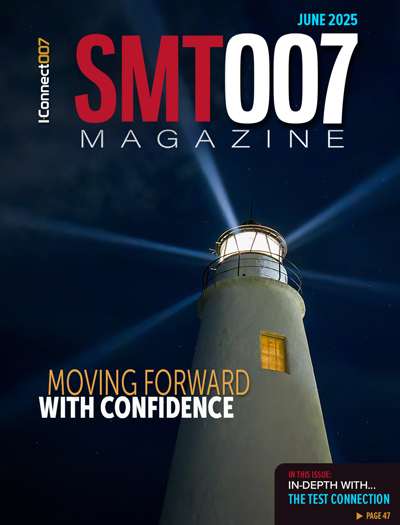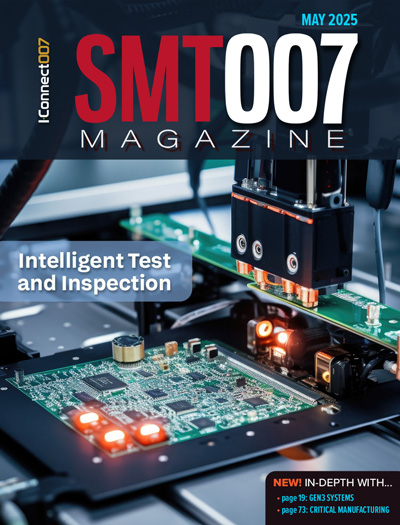-

- News
- Books
Featured Books
- smt007 Magazine
Latest Issues
Current Issue
What's Your Sweet Spot?
Are you in a niche that’s growing or shrinking? Is it time to reassess and refocus? We spotlight companies thriving by redefining or reinforcing their niche. What are their insights?

Moving Forward With Confidence
In this issue, we focus on sales and quoting, workforce training, new IPC leadership in the U.S. and Canada, the effects of tariffs, CFX standards, and much more—all designed to provide perspective as you move through the cloud bank of today's shifting economic market.

Intelligent Test and Inspection
Are you ready to explore the cutting-edge advancements shaping the electronics manufacturing industry? The May 2025 issue of SMT007 Magazine is packed with insights, innovations, and expert perspectives that you won’t want to miss.
- Articles
- Columns
- Links
- Media kit
||| MENU - smt007 Magazine
Electrolube on Managing Thermal Interfaces and Conformal Coatings
December 3, 2018 | Pete Starkey, I-Connect007Estimated reading time: 7 minutes
While visiting Electrolube at the electronica show in Munich, Germany, I was delighted to have the opportunity to talk to Jade Bridges, global technical support manager, about how to manage thermal interfaces for maximum heat transfer efficiency. She also provides an update on conformal coatings.
Pete Starkey: Can you tell me about recent developments in your thermal management materials? What's the market looking to achieve, and what's been coming out of your development labs to help them achieve it?
Jade Bridges: We've been working for a good while and have concentrated a lot of resources into extending our thermal management range. We've seen massive changes in the market with new applications coming from far and wide.
Starkey: Can you give me some examples?
Bridges: The LED industry is one we've focused on a lot where efficiency is key there. The automotive industry is another important area—basically, anywhere they need good heat dissipation. Electric vehicles are a key example in the automotive industry, as well as battery packs, etc.
We've looked at the requirements of these industries and how they differ from what we were doing 10, 15, and 20 years ago. It's a growing market, and the range of applications is expanding, so we decided to invest in a thermal management specialist team that solely concentrates on that area. We have chemists developing new technologies and making our current technologies even better. That's the basis of what that team does, which has resulted in a massive expansion of our range over the past four years not just in current product technology, but in new technology like our phase-change materials (PCMs), for example.
Starkey: Can you explain a little about what PCMs are and how they work? What are the benefits?
Bridges: Certainly. You apply PCMs to the substrate, and when it reaches its softening temperature, then it will “relax.” There's the concept that a PCM will be solid at one temperature and liquid at another, which has made people a little bit concerned that they will be subject to pump-out with changes in thermal expansion, but the reality is that it just softens. It’s a solid material once it’s applied to the substrate, and then around 50°C—depending on the exact softening temperature—it will soften slightly, and that allows everything to conform.
Starkey: So, you get better thermal contact with the device that you're heat-sinking?
Bridges: Yes, any remaining gaps or little air pockets due to unevenness of the surfaces are filled in.
Starkey: How are they applied?
Bridges: Our PCMs are very easy to apply via a stencil or a screen. You just put them onto the surface and allow the solvent to evaporate before putting on the mating interface.
Starkey: What sort of thicknesses do you apply?
Bridges: It’s very similar to thermal paste. Typically, 50 microns up to slightly higher, such as 100–150 microns. Obviously, that's controlled by the screen mesh or stencil design. The reality is that we get a much more stable product without pump-out at that same thickness as a thermal paste. Overall, that means the thermal resistance is much lower.
Starkey: What sort of thermal conductivity do you achieve?
Bridges: We have two products that we're promoting at the show—TPM350 and TPM550—which are 3.5 and 5.5 watts per metre Kelvin. We've also increased our range of what we offer in terms of thermal conductivity. That's our key focus at the moment, but we have a wide range of other thermal management products as well. We're expanding in all avenues.
Starkey: Is there anything further we need to talk about regarding thermal management materials?
Bridges: If anyone wants to see the products—particularly the PCMs—then we can do some demonstrations. That's something we're trying to focus on this time—allowing people to see the products in action and gain a better idea of what they are.
Starkey: I think your basic explanation removes a lot of mystery about PCMs, which is great. Many thanks. Changing the subject now, what is the industry asking for in conformal coating materials?
Bridges: The situation in conformal coatings is very similar to what's happening in thermal management—it’s another fast-growing market with an increasing variety of applications. Different industries are realizing that they need some level of protection because of warranties on electrical products and the importance that electronics continue to have in our everyday lives. As a result, that means harsher conditions, a longer working life, more thermal cycles or thermal shock conditions, and with conformal coatings—as in many other industries—it’s high throughput.
Starkey: What are the preferred chemistries for conformal coatings presently?
Bridges: There are lots of different chemistries available, and what people realize now is that you don't have to stick with an exact chemistry type to get what you need. The market is evolving, and there are hybrid chemistries out there. The UV-cure coating market is another example, but that's also something we've pushed. Traditional UV-cure coatings will be a dual-cure system of UV cure and moisture, possibly taking over seven days to reach full cure. It requires a hybrid chemistry within the system for that to work.
What we've developed and what we're demonstrating at electronica is 2K850—a two-component UV-cure coating. Since it’s two component, you don’t have issues with shadow areas not curing within a certain amount of time, which allows customers to control that process fully. When you put 2K850 through the UV-cure oven, everything that is exposed to UV will cure immediately. Anything that's not exposed to UV in the two-component system sets into action and everything will be cured within 16 to 24 hours. That's a massive improvement on the current situation.
Starkey: Is that at an ambient temperature? Will the cure carry on?
Bridges: Yes, it cures at ambient temperature, and if customers need to speed that up, it will heat cure as well. It’s a very flexible system because it’s 2K technology, which we've been pushing for a number of years now. We are demonstrating the process of 2K850 at our conformal coatings stand so that people can see how it sprays and applies, how thick it is, how it protects, and then moving onto the UV cure process, how to inspect it.
Starkey: Does the UV cure really just set it in place and you rely on the chemistry of the two pack to bring about the cure, or is it more subtle than that?
Bridges: In a way, yes, it’s a very clever technology. By passing it through UV, it will cure as you would normally expect it to. Mixing the two components together is what sets the product in other areas.
Starkey: You mentioned spraying for application methods.
Bridges: Yes, spray—it’s like any other conformal coating. You do have a different applicator because you're mixing the two components before spraying.
Starkey: Do you mix them at the point of application?
Bridges: Yes, it’s a two-component spray head with pumps that feed into a static mixer. Then, the static mixer goes through an atomizing spray cap, which allows the product to be applied to the board, and you program it in as normal.
Page 1 of 2
Suggested Items
Eco-Scouts Initiative: Rehm Apprentice Team Receives Jury Award
07/04/2025 | Rehm Thermal SystemsAt the end of May, as part of this year’s ECO-Scouts Initiative, 14 interdisciplinary apprentice teams from various companies presented their project results to a panel of experts.
Specially Developed for Laser Plastic Welding from LPKF
06/25/2025 | LPKFLPKF introduces TherMoPro, a thermographic analysis system specifically developed for laser plastic welding that transforms thermal data into concrete actionable insights. Through automated capture, evaluation, and interpretation of surface temperature patterns immediately after welding, the system provides unprecedented process transparency that correlates with product joining quality and long-term product stability.
Day 2: More Cutting-edge Insights at the EIPC Summer Conference
06/18/2025 | Pete Starkey, I-Connect007The European Institute for the PCB Community (EIPC) summer conference took place this year in Edinburgh, Scotland, June 3-4. This is the third of three articles on the conference. The other two cover Day 1’s sessions and the opening keynote speech. Below is a recap of the second day’s sessions.
Ventec Strengthens Commitment to Halogen-Free PCB Manufacturing in Europe
06/11/2025 | Ventec International GroupVentec International Group, the PCB materials innovator, manufacturer, supplier and one-stop shop for copper clad laminates, prepregs, as well as process consumables and PCB manufacturing equipment has established volume inventory of halogen-free FR4.1 and FR15.1 PCB materials at its European hub in Germany.
GEN3 Set to Host HATS²™ Technical Day at A.W. Technical Centre with Bob Neves
06/09/2025 | Gen3GEN3, a global leader in reliability testing and measurement solutions for the electronics industry, is excited to announce a dedicated HATS²™ Technical Day to be held at the A.W. Technical Centre in Farnborough, GEN3’s HQ. The event will showcase the HATS²™ (Highly Accelerated Thermal Shock) system with demos and presentations by Bob Neves, Chairman of RAS Inc. and creator of the HATS²™.


